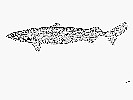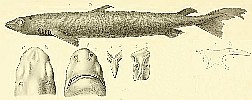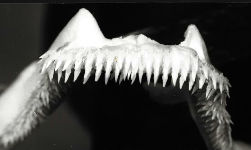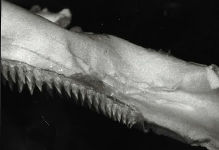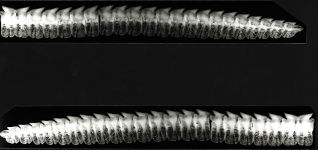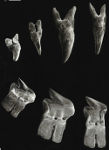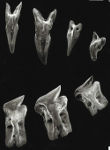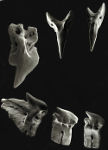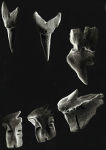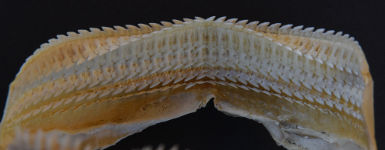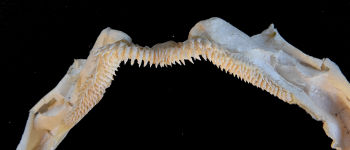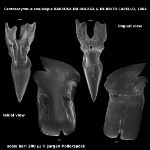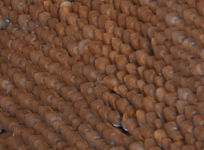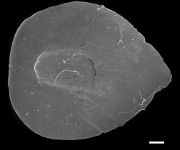Centroscymnus coelolepis
Barbosa Du Bocage & De Brito Capello, 1864
Portuguese dogfish
Classification: Elasmobranchii Squaliformes Somniosidae
Reference of the original description
Sur quelques espèces inédites de Squalidae de la tribu Acanthiana Gray, qui fréquentent les côtes du Portugal. Proceedings of the Zoological Society of London, 1864, 260–263
Sur quelques espèces inédites de Squalidae de la tribu Acanthiana Gray, qui fréquentent les côtes du Portugal. Proceedings of the Zoological Society of London, 1864, 260–263
Image of the original description

Centroscymnus coelolepis Barbosa du Bocage & de Brito Capello, 1864

Centroscymnus coelolepis Barbosa du Bocage & de Brito Capello, 1864
Synonyms / new combinations and misspellings
Centrophorus coelolepis, Centroscymnus cf. coelolepis, Centroscymnus coelolepsis, Centroscymnus macrops, Scymnodon melas
Centrophorus coelolepis, Centroscymnus cf. coelolepis, Centroscymnus coelolepsis, Centroscymnus macrops, Scymnodon melas
Types
Centroscymnus coelolepis
Holotype: MB: T.113 (destroyed by fire in 1978)
Centroscymnus macrops
Holotype: SCSFRI: O0150;
Scymnodon melas
Holotype: MCZ: 37452; Paratype: MCZ: ?;
Centroscymnus coelolepis
Holotype: MB: T.113 (destroyed by fire in 1978)
Centroscymnus macrops
Holotype: SCSFRI: O0150;
Scymnodon melas
Holotype: MCZ: 37452; Paratype: MCZ: ?;
Description :
Citation: Centroscymnus coelolepis Barbosa Du Bocage & De Brito Capello, 1864: In: Database of modern sharks, rays and chimaeras, www.shark-references.com, World Wide Web electronic publication, Version 01/2026
Please send your images of "Centroscymnus coelolepis" to info@shark-references.com
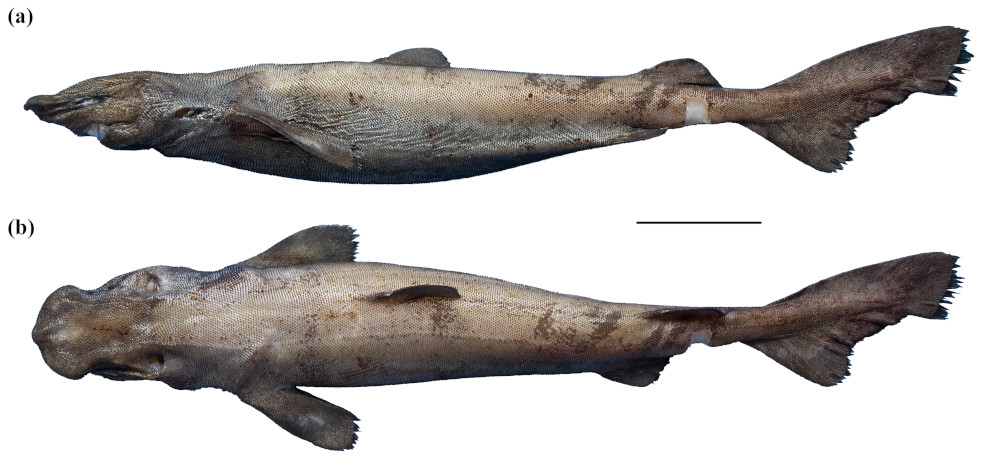
Centroscymnus coelolepis Barbosa du Bocage & de Brito Capello, 1864, juvenile, female; 361 mm LT; MHNM 4088; caught in the Southwestern Atlantic Ocean © Federico Mas

Centroscymnus coelolepis Barbosa du Bocage & de Brito Capello, 1864, juvenile, female; 361 mm LT; MHNM 4088; caught in the Southwestern Atlantic Ocean © Federico Mas
Common names
 Portugiesenhai,
Portugiesenhai,  Pailona,
Pailona,  Palluda,
Palluda,  Rasqueta,
Rasqueta,  Tiburón portugués,
Tiburón portugués,  Pailona commun,
Pailona commun,  Portugese dogfish,
Portugese dogfish,  Portuguese Shark,
Portuguese Shark,  Portuguese dogfish,
Portuguese dogfish,  Centroscimno,
Centroscimno,  Tubarão português,
Tubarão português,  Xara preta
Xara preta
 Portugiesenhai,
Portugiesenhai,  Pailona,
Pailona,  Palluda,
Palluda,  Rasqueta,
Rasqueta,  Tiburón portugués,
Tiburón portugués,  Pailona commun,
Pailona commun,  Portugese dogfish,
Portugese dogfish,  Portuguese Shark,
Portuguese Shark,  Portuguese dogfish,
Portuguese dogfish,  Centroscimno,
Centroscimno,  Tubarão português,
Tubarão português,  Xara preta
Xara preta
Short Description
Dorsal fins with very small spines, very short snout, lanceolate upper teeth and bladelike lower teeth with short, oblique cusps, stocky body that does not taper abruptly from pectoral region, very large lateral trunk denticles with smooth, circular, acuspidate crowns in adults and subadults [518]. Uniformly golden brown to dark brown in color [1388].
Dorsal fins with very small spines, very short snout, lanceolate upper teeth and bladelike lower teeth with short, oblique cusps, stocky body that does not taper abruptly from pectoral region, very large lateral trunk denticles with smooth, circular, acuspidate crowns in adults and subadults [518]. Uniformly golden brown to dark brown in color [1388].
Distribution
Western Atlantic: Grand Banks to Delaware, USA; Cuba [20078]. Eastern Atlantic: Iceland south along Atlantic slope to the southwestern Cape coast of South Africa; also western Mediterranean. Western Pacific: off Japan, New Zealand, and Australia [1388]. Also occurring in the Western Central Pacific [544]. Source: www.gbif.org
Western Atlantic: Grand Banks to Delaware, USA; Cuba [20078]. Eastern Atlantic: Iceland south along Atlantic slope to the southwestern Cape coast of South Africa; also western Mediterranean. Western Pacific: off Japan, New Zealand, and Australia [1388]. Also occurring in the Western Central Pacific [544]. Source: www.gbif.org
Human uses
fisheries: minor commercial; price category: low; price reliability: reliable: based on ex-vessel price for this species
fisheries: minor commercial; price category: low; price reliability: reliable: based on ex-vessel price for this species
Biology
Ovoviviparous [1388], with 13 to 29 young per litter [578]. Born at 27-31 cm [578]. Distinct pairing with embrace [17086]. Found almost exclusively on the lower slope of the Catalan Sea, western Mediterranean (Ref. 40720). Found on continental slopes and abyssal plains [1388]; usually in water temperature of 5-13°C (Ref. 5951). Feeds mainly on fishes (including sharks) and cephalopods [1388], also gastropods and cetacean meat [536].
Ovoviviparous [1388], with 13 to 29 young per litter [578]. Born at 27-31 cm [578]. Distinct pairing with embrace [17086]. Found almost exclusively on the lower slope of the Catalan Sea, western Mediterranean (Ref. 40720). Found on continental slopes and abyssal plains [1388]; usually in water temperature of 5-13°C (Ref. 5951). Feeds mainly on fishes (including sharks) and cephalopods [1388], also gastropods and cetacean meat [536].
Remarks
shark-references Species-ID=1281;
shark-references Species-ID=1281;
Parasites (arranged by Jürgen Pollerspöck)
Cestoda
Nematoda
Cestoda
- Clistobothrium montaukense Ruhnke, 1993 [20495]
- Clistobothrium sp. [25922] [28988]
- Grillotia adenoplusia (Pinter, 1903) [25922]
- Grillotia dolichocephala (Guiart, 1935) [16112]
- Hepatoxylon trichiuri (Holten, 1802) [16112]
- Monorygma sp. [20495] [25922] [28988]
- Pintneriella gymnorhynchoides (Guiart, 1935) [16210] [16112]
- Sphyriocephalus viridis (Wagener, 1854) Pintner, 1913 [16112] [25091] [25922]
- Tentacularia coryphaenae Bosc, 1797 [16112]
Nematoda
- Anisakis sp. [25922]








